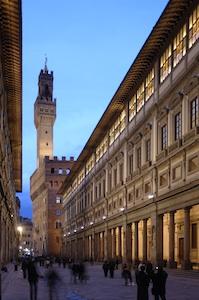Controversial plans to add a Japanese-designed loggia to Florence's famed Uffizi Gallery were back in question this week after Culture Minister Sandro Bondi gave the structure the thumbs down.
The minister said that while he admired architect Arata Isozaki's steel, polycarbonate and stone structure, he could not see how the building could ''harmonize well'' with its surroundings.
''How could it live alongside the adjacent loggias designed by (16th-century artist) Giorgio Vasari without shocking Florenitines and visitors from all over the world?'' he asked.
''It would provoke a kind of Stendhal's syndrome in reverse,'' he added, referring to the psychosomatic illness that causes rapid heartbeat, dizziness, confusion and even hallucinations when the individual is exposed to an overdose of beautiful art.
The minister told local paper Il Giornale dalla Toscana that he would discuss the fate of the loggia plan with Florence city council, who have okayed the addition.
Film and stage director Franco Zeffirelli, who has long campaigned against the Japanese addition, praised Bondi for his courage in speaking out against the work.
''We finally have a culture minister who has the courage to do the things that need to be done instead of being blackmailed by progressivist culture,'' he said.
''Florence could not bear that outrage. We were ready to chain ourselves to the building site, but I've always been sure that Florence could not seriously go ahead with that horror, that hoax, that practical joke,'' he said.
WORK CONTESTED FROM THE START.
Isozaki's design for the Uffizi exit in Piazza dei Castellani has divided opinion ever since it was first greenlighted in 1998 as part of expansion work at the gallery.
It came under fierce opposition from the then culture undersecretary, Vittorio Sgarbi, who called Isozaki's design ''anal,'' ''pederast'' and ''a sardine can''.
Because of Sgarbi's strictures, the signature project was altered to appease critics and was given a second go-ahead by the city council in 2006.
The loggia is part of an ambitious 60-million-euro refurbishment and development project which will more than double the exhibition space at the gallery to 12,000 square metres.
Work began on the expansion in January last year and will mean the Uffizi can eventually show more than 2,000 art works, compared to 1,200 at present, and admit double the number of visitors daily, from 4,000 to 8,000.
A tentative completion date has been fixed for 2013.
The Uffizi, an unusual U-shaped building, was begun in 1560 by artist and art critic Vasari and was completed according to his design by the architects Alfonso Parigi the Elder and Bernardo Buontalenti.
The gallery was commissioned by Duke of Florence and Grand Duke of Tuscany Cosimo I to serve as government offices, or 'uffici' in Italian, and hence Uffizi.
Isozaki, whose works include Barcelona's Olympic Stadium and a hockey stadium for the Turin Winter Olympics, is famed for his bold, colourful geometric forms and careful detailing.
His major works outside Japan include the Los Angeles Museum of Contemporary Art, the Disney Building at Orlando, Florida, the Barcelona sports palace in Spain and the Museum at La Coruna, also in Spain.





